29 MARCH – 4 APRIL 2025
By Luis Gles
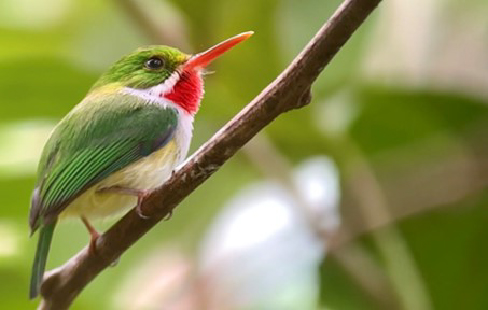
Puerto Rican Tody (photo Luis Gles).
Overview
Our set departure Puerto Rico Escape – Endemics and Island Birding tour had seven participants: Davie and Barbara from Australia, Pat, Kraig, and Lisa from Pennsylvania, and Laura and Ralph from West Virginia. The adventure began in San Juan, the capital of Puerto Rico, on March 29, 2025, and ended there again on April 4, 2025. This tour focused on all the island’s endemic birds, visiting the best birding destinations in Puerto Rico, including El Yunque National Forest, Rio Abajo State Forest, Humacao Nature Preserve, and Maricao Forest Reserve.
La Isla Del Encanto, as the locals call Puerto Rico, was unforgettable. We saw and enjoyed all of the island’s endemics like Elfin Woods Warbler, Puerto Rican Amazon, Yellow-shouldered Blackbird, Puerto Rican Bullfinch, Puerto Rican Lizard Cuckoo, Puerto Rican Spindalis, Adelaide’s Warbler, and Puerto Rican Tody. We also enjoyed many Caribbean specialties like Scaly-naped and Plain Pigeons, Red-legged Thrush, the always-shy Masked Duck, Pearly-eyed Thrasher, the elegant White-tailed Tropicbird, Caribbean Elaenia, Mangrove Cuckoo, Green-throated Carib, and Antillean Crested Hummingbird. All these birds, and many more, were part of the 108 birds we encountered, of which only one was heard and not seen. The species list is at the end of this report.
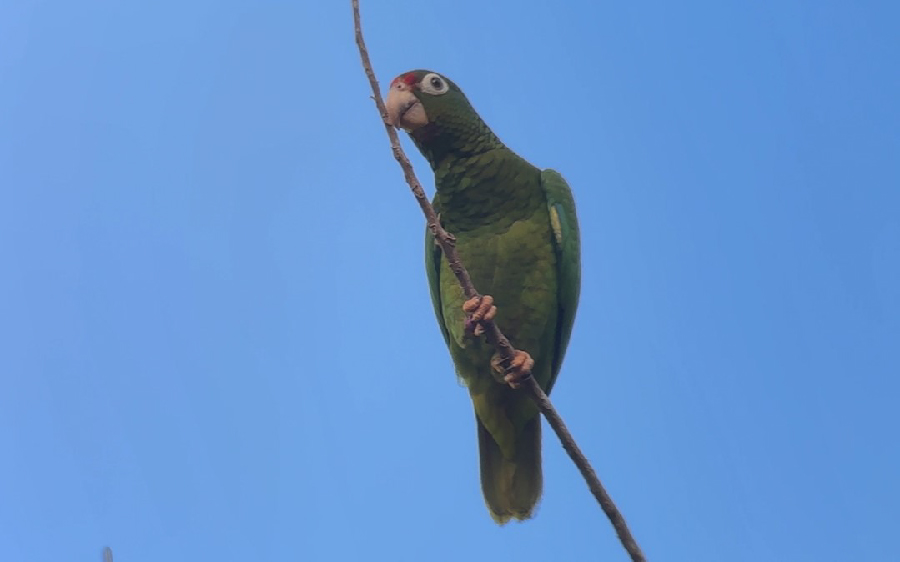
Puerto Rican Amazon (photo Luis Gles).
Detailed Report
Day 1, 29th March 2025. Arrival in San Juan
We started our tour in San Juan, where I (Luis) met five of the participants in the afternoon. Then, we fetched Ralph and Laura at the old San Juan (Zona Colonial), where they were as part of their pre-tour. We headed west to our hotel in the city of Manatí. After checking in and taking a short rest, we met at the lobby and walked to the restaurant located next to the hotel. We enjoyed a delicious meal and talked over the details of the upcoming tour.
Day 2, 30th March 2025. Northeast to southwest – Rio Abajo State Forest and Cambalache State Forest
Leaving our hotel early, we stopped for breakfast along the road in a classic Puerto Rican bakery. With our stomachs full, we headed to Rio Abajo State Forest in search of our main target for the day, and the most endangered endemic bird of the island, the Puerto Rican Amazon. This species has been a victim of the illegal pet trade and has suffered extensive habitat loss due to hurricanes, with Rio Abajo State Forest being its last stronghold. We arrived a few minutes before sunrise to see the birds leaving their roosting areas. We began walking down the trail and soon started hearing the loud noise of parrots. However, we didn’t see any until one flew over and landed in a semi-open area, where I was able to set up the scope for everyone to enjoy views of this Critically Endangered (BirdLife International) bird.
Along with the Puerto Rican Amazon,we were able to see other endemics, such as Puerto Rican Bullfinch, Puerto Rican Woodpecker, Puerto Rican Tody, Puerto Rican Lizard Cuckoo, Puerto Rican Oriole, Puerto Rican Spindalis, Green Mango, and Puerto Rican Vireo, another bird that can be challenging to connect with. Following a fantastic first birding session, we headed out to Cambalache State Forest in search of Adelaide’s Warbler, which we found. We also added Bananaquit, Black-whiskered Vireo, Northern Parula, Cave Swallow, Grey Kingbird, Mangrove Cuckoo, and Zenaida Dove.
We then continued west along the main highway, stopping along the road for delicious Puerto Rican sandwiches for lunch. Shortly after lunch, we stopped again at one of the tallest cliffs on the island, the breeding ground for one of the most elegant seabirds in the Caribbean, White-tailed Tropicbird. We were amazed by their flights and calls. We had stunning views of this unique bird, along with its cousin, Magnificent Frigatebird, which flew by at eye level to delight all of us. The trip ahead was long, so we continued driving south, in the direction of our base for the next couple of days, a lodge in the town of Parguera in the southwest of the island.
Before arriving at our destination for the night, we stopped to look at a colony of American White and Glossy Ibises. We also saw Orange-cheeked Waxbill, Western Cattle Egret, and Common Ground Dove. We checked in at our lodge, had dinner in the center of town, and then enjoyed a good night’s rest.
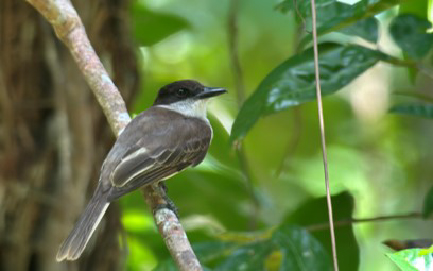
Loggerhead Kingbird (photo Luis Gles).
Day 3, 31st March 2025. Maricao Forest Reserve
We set off towards Maricao Forest Reserve, stopping off at another popular bakery in Las Lajas for a nice breakfast. A thirty-five-minute drive inland from the bakery in Las Lajas, we arrived at Maricao State Forest, which is located in the western Cordillera Central mountains in the southwest of Puerto Rico. This state forest is renowned for its elfin woods, which are rich in endemic flora and fauna, and is home to most of the island’s endemic birds. It is the best place to find the long-overlooked Elfin Woods Warbler, the main target for the morning.
We walked the first trail along the road and started noticing the expected endemics, such as Puerto Rican Lizard Cuckoo, Puerto Rican Woodpecker, and Puerto Rican Bullfinch. We also heard the song of the Black-whiskered Vireo, accompanied by the buzzing sound of Bananaquit, which was a constant accompaniment. Halfway down the trail, we heard the call of a Puerto Rican Tanager; we were really excited since this bird is in its own family, Nesospingidae. We tracked the call down and saw the bird really well. While enjoying this endemic bird, I found an occupied nest of Puerto Rican Emerald that was just behind us at that moment. As if this were not enough, nature elevated the moment with a pair of Elfin Woods Warblers. We changed our direction and headed to the main entrance. In the parking lot, we had the opportunity to study a pair of Puerto Rican Orioles that were nesting in a manga tree. Here, we also encountered other Caribbean specialties, such as the stunning and shy Pearly-eyed Thrasher, a flock of Caribbean Martins mixed with Cave Swallows, and Turkey Vultures were flying around. We also saw Puerto Rican Spindalis and Puerto Rican Tody, then headed down to the town of San Germán for lunch.
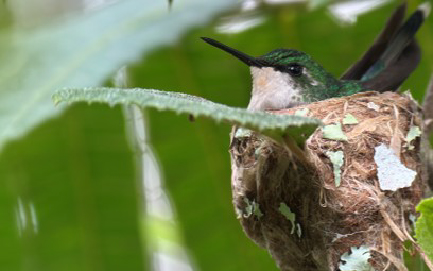
Puerto Rican Emerald (photo Luis Gles).
After lunch, we headed back to Maricao Forest Reserve to look for one more species that we had missed during the morning. We checked two new areas to cover more ground and hopefully connect with the euphonia, which still eluded us. During our search, we added new birds, including Red-tailed Hawk, White-crowned Pigeon, Green Mango, Puerto Rican Flycatcher, Red-legged Thrush, Shiny Cowbird, and Black-faced Grassquit. After a long search, we were losing hope and decided to return to the first trail we had tried early in the morning, before heading back to our lodge. Five minutes after arriving at the trail, I heard the distinctive whistle of a euphonia nearby. We ran up 150 feet and saw a female Puerto Rican Euphonia sitting conspicuously on top of an oak tree. What a relief after all the hard work! After enjoying this beautiful songbird, we returned to our lodge to rest before dinner and our owling scheduled for the evening.
On our way to the plaza where the restaurants are located, we enjoyed spotting some new birds, including Killdeer, Spotted Sandpiper, Clapper Rail, Osprey, and Brown Pelican. While enjoying drinks on the rooftop of the plaza, we saw flocks of the endangered and endemic Yellow-shouldered Blackbird flying to roost over the mangrove islands around La Parguera. After the avian sunset show, we had dinner and headed out for a short nighttime activity, where we added the endemic Puerto Rican Nightjar to conclude our third day in Puerto Rico.
Day 4, 1st April 2025. Birding Laguna Cartagena, Cabo Rojo, and other southwest Puerto Rico birding
We left our lodge early for another good breakfast at the bakery in Las Lajas, on our way to Laguna Cartagena. Here, we added some introduced old-world species, like Bronze Mannikin, African Collared Dove, and House Sparrow, and Venezuelan Troupial, introduced from South America. We also added migratory birds like Blue-winged Teal, Northern Parula, Prairie Warbler, and Belted Kingfisher. The highlights of the morning were Mangrove Cuckoo, Smooth-billed Ani, and Yellow-breasted Crake.
When we finished birding at the lagoon, we headed out to the southwest corner of the island to Cabo Rojo for lunch. On the way, we stopped for White-cheeked Pintail, Least Grebe, and Black-necked Stilt. We ate lunch with a view of the ocean, watching Brown Booby and Royal and Sandwich Terns flying offshore. We noticed a smaller booby and were surprised to find it was a dark morph Red-footed Booby!
After lunch, we walked along the warm trails of the Cabo Rojo. Here we enjoyed a large number of shorebirds, including Wilson’s and Snowy Plover, Hudsonian Whimbrel, Lesser and Greater Yellowlegs, and Stilt, Least, and Semipalmated Sandpipers. To conclude our excellent birding day, we had good views of Caribbean Elaenia, and we found the endemic Turk’s Head Cactus for David. We returned to our lodge, had an early dinner in town, and then went to bed.
Day 5, 2nd April 2025, Bosque Estatal de Susúa, and the southern edge of Puerto Rico in the direction of El Yunque National Forest
Following our tradition of early departure, we once again visited the bakery at Las Lajas before immersing ourselves in the beautiful forest of Bosque Estatal de Susúa. This state forest provided good views of White-winged Parakeet, Zenaida Dove, American Kestrel, Loggerhead Kingbird, and Puerto Rican Vireo. Pearly-eyed Thrasher was abundant. We saw boreal migrants, including Black-and-white Warbler, American Redstart, and the best view of the trip of the endemic Adelaide’s Warbler. We constantly heard the deep calls of Key West and Ruddy Quail-Dove, but didn’t see them well. With limited time remaining, we headed west and north to El Yunque National Forest and our last lodge of the trip, for the next two nights.
On our way to El Yunque, we had lunch at a classic Puerto Rican place in the south-central part of the island. Not far from there, we saw one of the most beautiful birds of the Caribbean, the Antillean Crested Hummingbird! After seeing this exquisite bird, we continued along the coast and then up into the hills in the northwest of the island until we arrived at our unique lodge, located almost at the top of the national forest.
After checking in, we relaxed and enjoyed some birding around the property and in the forest before dinner. After the meal, we checked the parking lot for the Puerto Rican Owl that was calling. The owl was our last Puerto Rican endemic; unfortunately, not all of us were able to see it well.
Day 6, 3rd April 2025. Birding Humacao Nature Preserve to Fajardo
Some of the participants who missed the owl the night before woke up earlier today. Hearing the calls of multiple Puerto Rican Owls, we stepped outside and looked for them until, finally, we spotted two of them for all of us to enjoy. We had achieved the primary purpose of this tour! We enjoyed a delicious breakfast at the lodge and prepared for departure. We visited a popular birding spot along the coast, the Humacao Nature Preserve. This preserve is renowned for its well-preserved mangrove forest, stunning beaches, and easy-to-follow trails. Since we had all the endemic species of the island, we focused on regional specialties, such as the Green-throated Carib, a hummingbird species associated with the Lesser Antilles, which is found only in the western part of Puerto Rico. Unfortunately, the weather was against us, and the wind was extreme, so it took more time than expected to find the hummingbird. After three hours, and with time running out before lunch, we miraculously found the bird in the front corner of the preserve. The Green-throated Carib was hiding from the strong winds and making short flights. We set the scope up and waited until all of us had seen the bird.
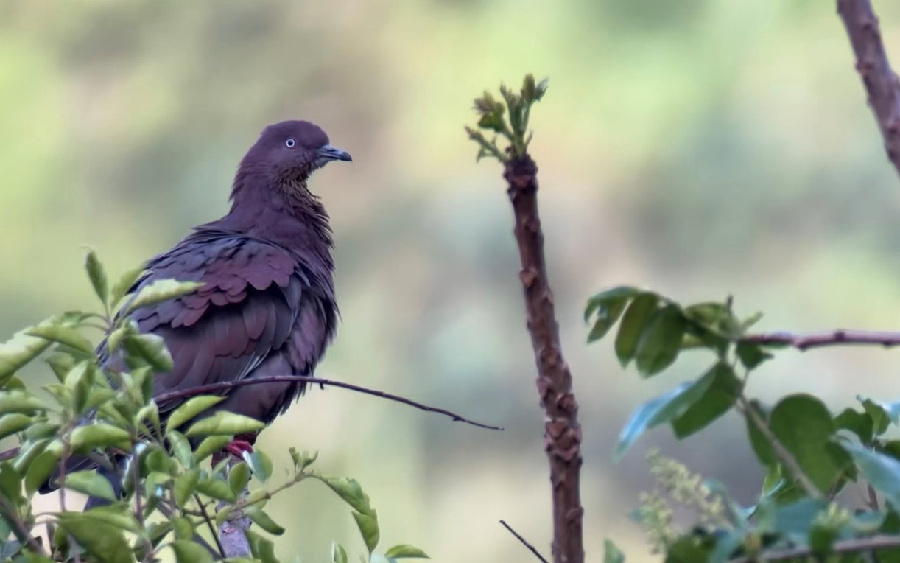
Plain Pigeon (photo Luis Gles).
We left the park to have lunch in the town of Humacao, on our way to the lodge. After lunch, we relaxed at the property. Some of us watched the feeding flocks of Puerto Rican Spindalis and Puerto Rican Tanager passing by, and Loggerhead Kingbirds nesting in the palm in front of the dining room.
Following a well-deserved rest, we headed southwest along the hillside in search of another Caribbean specialty. We drove for over 40 minutes to the small town of Caguas. After a further 20 minutes of walking and moving around the San Lorenzo River, we found our last target for the trip, the gorgeous and elegant Plain Pigeon, sitting in perfect light. The bird was extremely cooperative, and we all had excellent views through the scope. To conclude this fantastic day, and the whole trip, we headed to a Spanish restaurant and had a feast to celebrate. We returned to the lodge after dinner to prepare for the departure day.
Day 7, 4th April 2025. El Yunque and departure from San Juan
Our final morning was a little rushed due to some flight complications, and we had to depart earlier than expected. Nevertheless, we had another great breakfast at the property, and then set off on the 90-minute drive to San Juan International Airport. After dropping off the first part of the group at the airport, the rest of the group went on a short visit to the north side of El Yunque National Forest, where we walked along some trails and browsed for souvenirs at the visitor center. Here in the middle of nature, we had our last lunch together, before heading out to the airport and finishing another successful Birding Ecotours tour in Puerto Rico, La Isla Del Encanto.
Bird List – Following AviList (v2025)
Birds ‘heard only’ are marked with (H) after the common name, all other species were seen.
The following notation after species names is used to show conservation status following BirdLife International: CE = Critically Endangered, EN = Endangered, VU = Vulnerable, NT = Near Threatened.
| Common Name | Scientific Name |
| Ducks (Anatidae) | |
| Blue-winged Teal | Spatula discor |
| White-cheeked Pintail | Anas bahamensis |
| Grebes (Podicipedidae) | |
| Least Grebe | Tachybaptus dominicus |
| Pied-billed Grebe | Podilymbus podiceps |
| Pigeons, Doves (Columbidae) | |
| Rock Dove | Columba livia |
| Scaly-naped Pigeon – NT | Patagioenas squamosa |
| White-crowned Pigeon | Patagioenas leucocephala |
| Plain Pigeon – NT | Patagioenas inornata |
| Common Ground Dove | Columbina passaria |
| Key West Quail-Dove | Geotrygon chrysia |
| Eurasian Collared Dove | Streptopelia decaocto |
| African Collared Dove | Streptopelia roseogrisea |
| White-winged Dove | Zenaida asiatica |
| Zenaida Dove | Zenaida aurita |
| Mourning Dove | Zenaida macroura |
| Anis, Cuckoos (Cuculidae) | |
| Smooth-billed Ani | Crotophaga ani |
| Mangrove Cuckoo | Coccyzus minor |
| Puerto Rican Lizard Cuckoo | Coccyzus vieilloti |
| Hummingbirds (Trochilidae) | |
| Green Mango | Anthracothorax dominicus |
| Green-throated Carib | Eulampis holosericeus |
| Antillean Created Hummingbird | Orthorthycus cristatus |
| Puerto Rican Emerald | Ricccordia maugaeus |
| Coots (Rallidae) | |
| Common Gallinule | Gallinula galeata |
| Clapper Rail | Rallus crepitant |
| Yellow-breasted Crake | Laterals flaviventer |
| Stilts, Avocets (Recurvirostridae) | |
| Black-necked Stilt | Himantopus mexicanus |
| Plovers (Charadriidae) | |
| Grey Plover – VU | Pluvialis squatarola |
| Killdeer – NT | Charadrius vociferus |
| Snowy Plover – NT | Anarhychus nivosus |
| Willson’s Plover | Anarhynchus wilsonia |
| Sandpipers and Allies (Scolopacidae) | |
| Hudsonian Whimbrel | Numenius hudsonicus |
| Least Sandpiper | Calidris minutilla |
| Spotted Sandpiper | Actitis macularius |
| Greater Yellowlegs – NT | Tringa melanoleuca |
| Lesser Yellowlegs – VU | Tringa flavipes |
| Ruddy Turnstone – NT | Arenaria interpres |
| Stilt Sandpiper – NT | Calidris himantopus |
| Semipalmated Sandpiper – NT | Calidris pusilla |
| Gulls, Terns, Skimmers (Laridae) | |
| Laughing Gull | Leucophaeus atricilla |
| Sandwich Tern | Hydroprogne cassia |
| Royal Tern | Thalasseus maximus |
| Tropicbirds (Phaethontidae) | |
| White-tailed Tropicbird | Phaethon lepturus |
| Frigatebirds (Fregatidae) | |
| Magnificent Frigatebird | Fregata magnificens |
| Pelicans (Pelecanidae) | |
| Brown Pelican | Pelecanus occidentalis |
| Herons (Ardeidae) | |
| Great Blue Heron | Ardea herodias |
| Great Egret | Ardea alba |
| Snowy Egret | Egretta thula |
| Little Blue Heron | Egretta caerulea |
| Tricolored Heron | Egretta tricolor |
| Western Cattle Egret | Bubulcus ibis |
| Green Heron | Butorides virescens |
| American White Ibis | Eudocimus albus |
| Glossy Ibis | Plegadis flcinellus |
| Least Bittern | Botaurus exilis |
| Vultures (Cathartidae) | |
| Turkey Vulture | Cathartes aura |
| Hawks, Eagles (Accipitridae) | |
| Osprey | Pandion haliaetus |
| Red-tailed Hawk | Buteo jamaicensis |
| Barn Owls (Tytonidae) | |
| American Barn Owl | Tyto alba |
| Owls (Strigidae) | |
| Puerto Rican Owl | Gymnasia nudipes |
| Nightjars (Caprimulgidae) | |
| Puerto Rican Nightjar – VU | Antrostomus cubanensis |
| Todies (Todidae) | |
| Puerto Rican Tody | Todus mexicanus |
| Kingfishers (Alcedinidae) | |
| Belted Kingfisher | Megaceryle alcyon |
| Woodpeckers (Picidae) | |
| Puerto Rican Woodpecker | Melanerpes portoricensis |
| Caracaras, Falcons (Falconidae) | |
| American Kestrel | Falco sparveriusa |
| Merlin | Falco columbarium |
| Parrots (Psittacidae) | |
| Puerto Rican Amazon – CR | Amazonas vittata |
| Monk Parakeet | Myiopsitta monachus |
| White-winged Parakeet | Brotogeris versicolurus |
| Flycatchers (Tyrannidae) | |
| Caribbean Elaenia | Elaenia martinica |
| Lesser Antillean Pewee | Contopus latirostris |
| Puerto Rican Flycatcher | Myiarchus antillarum |
| Grey Kingbird | Tyrannus dominicensis |
| Loggerhead Kingbird | Tyrannus caudifasciatus |
| Vireos (Vireonidae) | |
| Puerto Rican Vireo | Vireo latimeri |
| Black-whiskered Vireo | Vireo altiloquus |
| Swallows, Martins (Hirundinidae) | |
| Caribbean Martin | Progne dominicensis |
| Barn Swallow | Hirundo rustica |
| Cave Swallow | Petrochelidon fulva |
| Mockingbirds, Thrashers (Mimidae) | |
| Northern Mockingbird | Mimus polyglottos |
| Pearly-eyed Thrasher | Margarops fuscatus |
| Thrushes (Turdidae) | |
| Red-legged Thrush | Turdus plumbeus |
| Waxbills, Munias & Allies (Estrildidae) | |
| Bronze Mannikin | Spermestes cucullata |
| Orange-cheeked Waxbill | Estrilda melpoda |
| Scaly-breasted Munia | Lonchura punctulata |
| Old World Sparrows, Snowfinches (Passeridae) | |
| House Sparrow | Passer domesticus |
| Euphonias, Crossbills (Fringillidae) | |
| Puerto Rican Euphonia | Chlorophonia sclateri |
| Puerto Rican Tanager (Nesospingidae) | |
| Puerto Rican Tanager – VU | Nesospingus speculiferus |
| Spindalis (Spindalidae) | |
| Puerto Rican Spindalis | Spindalis portoricensis |
| New World Blackbirds (Icteridae) | |
| Venezuelan Troupial | Icterus icterus |
| Puerto Rican Oriole | Icterus portoricensis |
| Yellow-shouldered Blackbird – EN | Agelaius xanthomus |
| Shiny Cowbird | Molothrus bonariensis |
| Greater Antillean Grackle | Quiscalus niger |
| Neotropical Warblers (Parulidae) | |
| Northern Waterthrush | Parkesia noveboracensis |
| Black-and-white Warbler | Mniotilta varia |
| Elfin Woods Warbler – EN | Setophaga angelae |
| American Redstart | Setophaga rutucilla |
| Northern Parula | Setophaga americana |
| Yellow Warbler | Setophaga petechia |
| Black-throated Blue Warbler | Setophaga caerulescens |
| Prairie Warbler | Setophaga discolor |
| Adelaide’s Warbler | Setophaga adelaidae |
| Bananaquit, Grassquits, Tanagers (Thraupidae) | |
| Bananaquit | Coereba flaveola |
| Yellow-faced Grassquit | Tiaris olivaceus |
| Puerto Rican Bullfinch – VU | Melopyrrha portoricensis |
| Black-faced Grassquit | Melanospiza bicilor |
| Total seen | 107 |
| Total heard | 1 |
| Total recorded | 108 |
This is a sample trip report. Please email us ([email protected]) for more trip reports from this destination.
